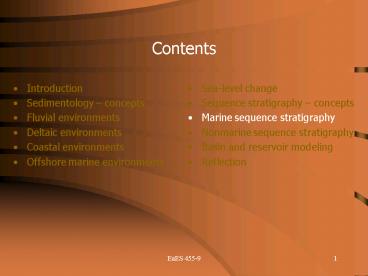Contents PowerPoint PPT Presentation
1 / 17
Title: Contents
1
Contents
- Introduction
- Sedimentology concepts
- Fluvial environments
- Deltaic environments
- Coastal environments
- Offshore marine environments
- Sea-level change
- Sequence stratigraphy concepts
- Marine sequence stratigraphy
- Nonmarine sequence stratigraphy
- Basin and reservoir modeling
- Reflection
2
Marine sequence stratigraphy
- The marine realm is considered here to include
the shoreline, shelf, continental slope, and deep
sea - The shoreline is perhaps the most sensitive
component with respect to eustatic control it
can migrate along dip over long distances
(sometimes up to 100s of km) as a result of - RSL change
- Variations in hinterland sediment supply
- Autogenic processes (e.g., delta-lobe switching)
3
(No Transcript)
4
Panorama
5
Marine sequence stratigraphy
- Bruuns Rule predicts that a shoreface remains
more or less constant during sea-level change
(equilibrium profile), with associated erosion
and deposition this 2D model is a tremendous
simplification of reality - The distinction between forced regression and
normal regression is critical to infer the
relative roles of RSL change and sediment supply - Normal regression constitutes shoreface
progradation due to excess sediment supply - Forced regression is driven by RSL fall and is
associated with a regressive surface of erosion
with shoreface strata sharply overlying
fine-grained, offshore strata
6
(No Transcript)
7
(No Transcript)
8
Marine sequence stratigraphy
- Bruuns Rule predicts that a shoreface remains
more or less constant during sea-level change
(equilibrium profile), with associated erosion
and deposition this 2D model is a tremendous
simplification of reality - The distinction between forced regression and
normal regression is critical to infer the
relative roles of RSL change and sediment supply - Normal regression constitutes shoreface
progradation due to excess sediment supply - Forced regression is driven by RSL fall and is
associated with a regressive surface of erosion
with shoreface strata sharply overlying
fine-grained, offshore strata
9
(No Transcript)
10
Marine sequence stratigraphy
- Ravinement surfaces form during the landward
migration of a shoreline due to transgression - Wave ravinement surfaces are widespread erosion
surfaces formed by the stripping of a relatively
thin deposit by wave action - Tidal ravinement surfaces are more localized, but
commonly deeper erosive features associated with
tidal channels - Shelf-edge deltas form during lowstand when RSL
is close to the shelf break they have a fairly
high preservation potential
11
(No Transcript)
12
(No Transcript)
13
Marine sequence stratigraphy
- Ravinement surfaces form during the landward
migration of a shoreline due to transgression - Wave ravinement surfaces are widespread erosion
surfaces formed by the stripping of a relatively
thin deposit by wave action - Tidal ravinement surfaces are more localized, but
commonly deeper erosive features associated with
tidal channels - Shelf-edge deltas form during lowstand when RSL
is close to the shelf break they have a fairly
high preservation potential
14
(No Transcript)
15
(No Transcript)
16
Marine sequence stratigraphy
- Sedimentation in the deep sea is commonly
believed to be strongly controlled by eustasy - RSL fall and lowstand brings the shoreline close
to, or below the shelf break, and provides a
mechanism for rapid transfer of sediment to the
deep-sea floor RSL fall is associated with
relatively coarse-grained (sandy) sediment
gravity flows, whereas turbidites forming
well-developed submarine fans follow during
lowstand - Accommodation creation on the shelf during RSL
rise and highstand reduces sediment supply to the
slope and deep sea, and predominance of
hemipelagic facies - Many exceptions are possible for instance, a
limited shelf width and a high sediment supply
from the hinterland can combine to allow rapid
progradation of shorelines to the shelf edge even
during highstand
17
(No Transcript)

